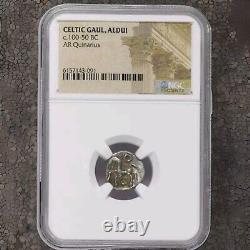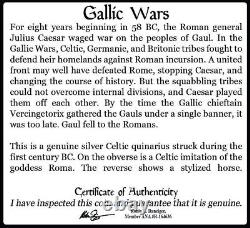NGC Celtic Tribes in Ancient Gaul Quinarius Silver & Gallic Wars Caesar vs. Celt







NGC Lower Grade Celtic Tribes in Ancient Gaul Quinarius Silver. Over an eight-year period starting in 58 BC, Roman general Julius Caesar conducted a military campaign against the tribes of Gaul. In the Gallic Wars, Celtic, Germanic, and Britonic groups resisted Roman expansion to defend their territories.
The potential for a united resistance against Rome existed, which could have altered history by thwarting Caesar. However, internal divisions among the tribes hindered a cohesive front, allowing Caesar to manipulate them. By the time Gallic chieftain Vercingetorix sought unity, it proved too late, and Gaul succumbed to Roman rule.
The featured coin is an authentic silver Celtic quinarius from the first century BC, displaying a Celtic rendition of the goddess Roma on the obverse-common on Roman coins of the period-and a stylized horse on the reverse. Stock Photos Used - You Will Receive the Same Type/Quality of coin shown. For eight years beginning in 58 BC, the Roman general Julius Caesar waged war on the peoples of Gaul. In the Gallic Wars, Celtic, Germanic, and Britonic tribes fought to defend their homelands against Roman incursion. A united front may well have defeated Rome, stopping Caesar, and changing the course of history.
But the squabbling tribes could not overcome internal divisions, and Caesar played them off each other. By the time the Gallic chieftain Vercingetorix gathered the Gauls under a single banner, it was too late.Gaul fell to the Romans. This is a genuine silver Celtic quinarius struck during the first century BC. On the obverse is a Celtic imitation of the goddess Roma, common on Roman coins of the period. The reverse shows a stylized horse.

